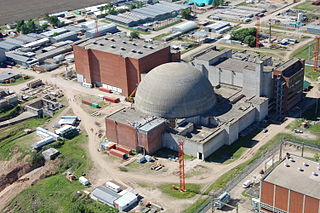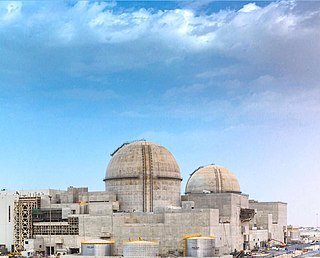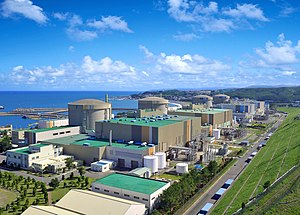
The CANDU is a Canadian pressurized heavy-water reactor design used to generate electric power. The acronym refers to its deuterium oxide moderator and its use of uranium fuel. CANDU reactors were first developed in the late 1950s and 1960s by a partnership between Atomic Energy of Canada Limited (AECL), the Hydro-Electric Power Commission of Ontario, Canadian General Electric, and other companies.

A nuclear reactor is a device used to initiate and control a fission nuclear chain reaction or nuclear fusion reactions. Nuclear reactors are used at nuclear power plants for electricity generation and in nuclear marine propulsion. Heat from nuclear fission is passed to a working fluid, which in turn runs through steam turbines. These either drive a ship's propellers or turn electrical generators' shafts. Nuclear generated steam in principle can be used for industrial process heat or for district heating. Some reactors are used to produce isotopes for medical and industrial use, or for production of weapons-grade plutonium. As of 2022, the International Atomic Energy Agency reports there are 422 nuclear power reactors and 223 nuclear research reactors in operation around the world.

Bruce Nuclear Generating Station is a nuclear power station located on the eastern shore of Lake Huron in Ontario, Canada. It occupies 932 ha of land. The facility derives its name from Bruce Township, the local municipality when the plant was constructed, now Kincardine due to amalgamation. With eight CANDU pressurized heavy-water reactors, it was the world's largest fully operational nuclear generating station by total reactor count and the number of currently operational reactors until 2016, when it was exceeded in nameplate capacity by South Korea's Kori Nuclear Power Plant. The station is the largest employer in Bruce County, with over 4000 workers.
Kaiga Generating Station is a nuclear power generating station situated at Kaiga, near the river Kali, in Uttara Kannada district of Karnataka, India. The plant has been in operation since March 2000 and is operated by the Nuclear Power Corporation of India.
Nuclear power in Canada is provided by 19 commercial reactors with a net capacity of 13.5 gigawatt (GW), producing a total of 95.6 terawatt-hours (TWh) of electricity, which accounted for 16.6% of the country's total electric energy generation in 2015. All but one of these reactors are located in Ontario, where they produced 61% of the province's electricity in 2019. Seven smaller reactors are used for research and to produce radiopharmaceuticals for use in nuclear medicine.
Korea Hydro & Nuclear Power is a subsidiary of the Korea Electric Power Corporation (KEPCO). It operates large nuclear and hydroelectric plants in South Korea, which are responsible for about 27 percent of the country's electric power.
The Karachi Nuclear Power Plant is a large commercial nuclear power plant located at the Paradise Point in Karachi, Sindh, Pakistan.

Tarapur Atomic Power Station (T.A.P.S.) is located in Tarapur, Palghar, India. It was the first commercial nuclear power station built in India.
Nuclear power is a major power source in South Korea, providing 29% of the country's electricity. The total electrical generation capacity of the nuclear power plants of South Korea is 20.5 GWe from 23 reactors, equivalent to 22% of South Korea's total electrical generation capacity.

The Rajasthan Atomic Power Station is located at Rawatbhata in the state of Rajasthan, India.
Nuclear power is the fifth-largest source of electricity in India after coal, gas, hydroelectricity and wind power. As of November 2020, India has 22 nuclear reactors in operation in 8 nuclear power plants, with a total installed capacity of 7,380 MW. Nuclear power produced a total of 43 TWh in 2020-21, contributing 3.11% of total power generation in India. 10 more reactors are under construction with a combined generation capacity of 8,000 MW.

Narora Atomic Power Station (NAPS) is a nuclear power plant located in Narora, Dibai Tehsil, Bulandshahar District in Uttar Pradesh, India.

The Hanul Nuclear Power Plant is a large nuclear power station in the Gyeongsangbuk-do province of South Korea. The facility has six pressurized water reactors (PWRs) with a total installed capacity of 5,881 MW. The first went online in 1988. In the early 2000s it was the third largest operational nuclear power plant in the world and the second largest in South Korea. The plant's name was changed from Uljin to Hanul in 2013.

The Wolseong Low and Intermediate Level Radioactive Waste Disposal Centre (WLDC) is a facility used to safely house Low to Intermediate Level radioactive waste (LILW) at Gyeongju in South Korea. The facility features a silo-type design, and its first stage allowed for up to 100,000 barrels of storage, which increased to a total capacity of 800,000 upon completion of the final stage.

The Atucha Nuclear Complex, or Atucha Nuclear Power Plant, is the location for two adjacent nuclear power plants in Lima, Zárate, Buenos Aires Province, about 100 kilometres (60 mi) from Buenos Aires, on the right-hand shore of the Paraná de las Palmas River. Both are pressurized heavy-water reactors (PHWR) employing a mixture of natural uranium and enriched uranium, and use heavy water for cooling and neutron moderation.

The APR-1400 is an advanced pressurized water nuclear reactor designed by the Korea Electric Power Corporation (KEPCO). Originally known as the Korean Next Generation Reactor (KNGR), this Generation III reactor was developed from the earlier OPR-1000 design and also incorporates features from the US Combustion Engineering (C-E) System 80+ design. Currently in South Korea there are 3 units in operation, and 3 units in construction. Two units are completed and in commercial operation in the United Arab Emirates at Barakah, with two more under construction at the same plant.

The IPHWR-700 is an Indian pressurized heavy-water reactor designed by the Bhabha Atomic Research Centre. It is a Generation III reactor developed from earlier CANDU based 220 MW and 540 MW designs. It can generate 700 MW of electricity. Currently there are 6 units under construction and 10 more units planned, at a cost of INR 1.05 trillion.

The IPHWR-220 is an Indian pressurized heavy-water reactor designed by the Bhabha Atomic Research Centre. It is a Generation II reactor developed from earlier CANDU based RAPS-1 and RAPS-2 reactors built at Rawatbhata, Rajasthan. The design was later expanded into 540 MW and 700 MW designs. It can generate 220 MW of electricity. Currently there are 14 units operational at various locations in India.

The IPHWR is a class of Indian pressurized heavy-water reactors designed by the Bhabha Atomic Research Centre. The baseline 220 MWe design was developed from the CANDU based RAPS-1 and RAPS-2 reactors built at Rawatbhata, Rajasthan. The design was later expanded into 540 MW and 700 MW designs. Currently there are 17 units of various types operational at various locations in India.













